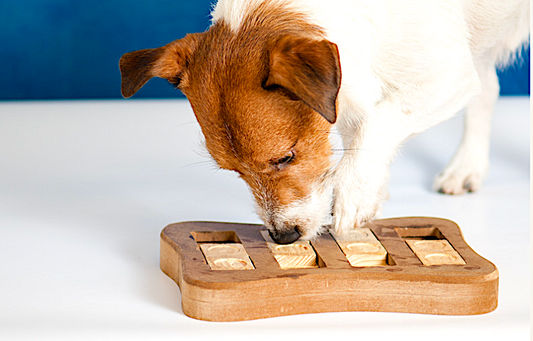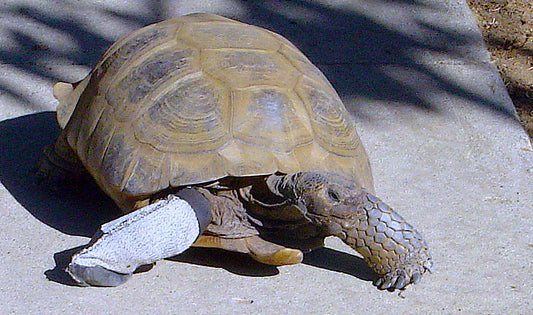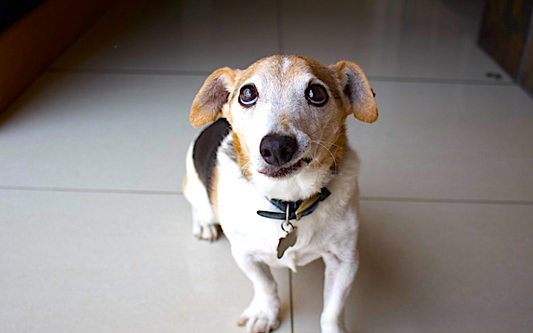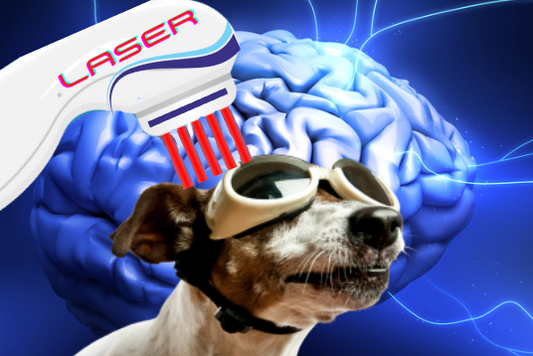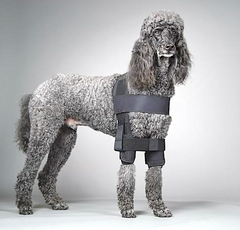Dogs can contort their bodies in incredible ways; they are amazing athletes! It's no wonder that injuries happen when their shoulders get bent or turned the wrong way.

The Shoulder Joint
Shoulder joints in humans are easy to find and palpate (feel) since they lie on the outer sides of the body. The shoulder joint of the dog is more elusive; it lies against their front chest and can be hard to feel, especially in dogs with lots of muscle and thick coats. Below is a photo of a dog jumping - note that the shoulder is located next to their chest and is shown with the blue arrow; not to be confused with the dog's elbow, which is shown with the pink arrow.

Human shoulders are the most mobile joints in the body allowing arms to move in any direction. A dog's shoulder is not that mobile. It is mainly able to move the dog's leg forward and backward and allows only a little outward and inward (sideways) movement or rotation.
Who, What, and Why
There are many types of injuries and issues that may affect the shoulder including tears, sprains, and strains to muscles or ligaments, overuse injuries, and arthritis or osteochondritis dissecans (OCD) affecting the joint and bone.
- OCD is more common in young dogs, but it is more often the older or more mature dogs that sustain injuries to the shoulder.
- Active dogs like hunting, military, and trail-hiking dogs are susceptible to shoulder injuries because they run on uneven ground and through rough terrain. Stepping in a hole, bumping against a rock or log, or falling are common causes of shoulder injuries.
- Canine athletes such as agility, flyball, and dock-diving dogs are at higher risk of stressing and injuring shoulder muscles and tendons because these sports involve high-impact activities and repetitive movements like jumping, fast turns, and weave poles. In fact, an article that was published in the Journal of the American Veterinary Medical Association (Nov. 1, 2021, Vol. 259) showed that shoulder injuries were the most common orthopedic injuries reported by owners of competing agility dogs (see reference at end of article).
Slips, slides, and falls can also cause microtraumas to the shoulder. Microtraumas are small injuries that usually go unnoticed since they don't seriously impact the dog's mobility or physical ability. But microtraumas can add up quickly, and all it takes is a small bump or sharp turn to change a microtrauma into a more serious injury with severe lameness. Have you ever moved large boxes or something heavy without incident and then bent down to pick a toy off the floor and your back went out? Those are accumulated microtraumas at work - adding up without issue but then causing injury doing something relatively easy. For more on types of injuries, see references at the end of this article.
How Can You Tell?
The telltale sign of a shoulder injury is limping on one front leg. Of course, limping can be caused by so many things that are unrelated to the shoulder. Problems that cause a dog to limp can stem from the neck (e.g., pinched nerve) or the paw (e.g., cut paw pad) or anywhere in between. So how can you tell?
An injury stemming from the shoulder often gets worse with exercise. A dog might have a shorter stride length and an agility dog may start knocking down bars or slowing through weave poles. But very often, pain and lameness tend to get worse after any type of moderate exercise.
A thorough, manual evaluation that includes range of motion of the shoulder joint and palpation of the surrounding tendons can be very revealing. A veterinary professional might order diagnostics such as X-ray, MRI, musculoskeletal ultrasound, and arthroscopy, which is the best way to confirm where the injury lies and how severe it is. Musculoskeletal ultrasound detects muscle and tendon injuries, and is a diagnostic tool that many pet parents prefer because it's non-invasive and does not require the dog to be sedated.

Dog relaxed (not sedated) undergoing musculoskeletal ultrasound of the shoulder (photo courtesy of STAAR Conference)
How Is a Shoulder Injury Treated?
Conservative Treatment
It is important to note that shoulder joints are difficult to rest properly because of their location on the dog's body. It is difficult to immobilize the shoulder for healing because while the dog walks, the shoulder continues to move. Even with a shoulder brace there is some movement that occurs. So shoulder recovery can be long, and normal activities are returned to very gradually.
Treatments for shoulder injuries depend on the type of injury and its severity. Most injuries will require a period of rest or crate confinement, along with non-steroidal anti-inflammatory medication (NSAIDs), controlled leash walks, and an at-home exercise program. Treatment protocols also take into account the dog's age, activity level, other medical issues, and living environment (e.g., is the dog alone during the day while you're at work or is someone available to watch him). You may be given an exercise-progression and modalities (e.g., ice packs) protocol to follow at home if you're not able to see your veterinary professional regularly.

Range of motion and stretching exercises for the shoulder (photo courtesy of STAAR Conference)
For high-energy dogs that are difficult to contain (you know the ones :-), a protective shoulder stabilization brace might be prescribed like this one below.
Dog in a shoulder stabilization system (photo courtesy of DogLeggs)
In-clinic physical therapy is beneficial since rehabilitation programs are tailored to your dog, and their progress is monitored carefully and modified as needed. Rehab programs might include laser therapy, therapeutic ultrasound, pulsed electromagnetic field (PEMF), therapeutic massage, acupuncture, therapeutic exercises, tensor bandage braces, and mild hydrotherapy exercises for strengthening weakened muscles. Your veterinary professional may even prescribe rehabilitation as a first resort to see if this conservative approach is all that's needed. Rehabilitation and physical therapy may also be prescribed for dogs where anesthesia and surgery are too risky.
 |
Strategic tensor bandage wrap application to help stabilize the shoulder - courtesy of L. Edge-Hughes at FourLeg Rehab |
 |
Resistance band tugs as an example of therapeutic exercises - courtesy of L. Edge-Hughes at FourLeg Rehab |
For a physical therapy practice near you, see the Map of Rehab Centers.
When Surgery is Recommended
For dogs with more severe injuries, long-standing lameness, and those that are not helped by conservative methods, surgery may give your dog the best possible chance at returning to their pre-injury activities. There are several different types of surgical procedures including stabilization, shoulder fusion (arthrodesis), and even total shoulder replacement. For more on types of surgeries, see references at the end of this article.
Preventing Shoulder Injury or Re-Injury
Most of us know that once we've had an injury, say a sprained ankle, it is much easier to re-injure that area. The same is true for shoulder injuries in dogs. Warm-up and cool-down exercises before and after activity take just a few minutes and can really help reduce injuries and re-injuries. Also, varying your activities will minimize overuse and repetitive stress on the shoulder. There are many great online courses on warming up, cooling down, stretching, and other foundational skills to help keep your dog safe and injury-free. Here are 3 of the top courses:
A final but important note deals with safety in the home while your dog is recovering. Since dogs spend more time indoors while they are healing, there is more opportunity for them to slip on hardwood or tile floors. Slips that cause the front legs to splay can easily re-injure a dog. Traction aids like yoga mats and traction socks are recommended to use indoors to protect your dog from further trauma.
Shoulder injuries should be considered and investigated as a possible reason for front leg lameness. A thorough veterinary exam including manual assessment and diagnostics can help determine the location and severity of the injury. Rest, controlled activities, physical therapy, a safe home environment, and a gradual return to normal activities is the best chance that pets have towards recovery.
References
https://dogshealthproblems.com/types-of-shoulder-injuries-in-dogs/
https://www.ridgereferrals.co.uk/pet-owners/factsheet/shoulder-injuries-in-dogs/
https://wagwalking.com/condition/shoulder-joint-ligament-and-tendon-conditions
https://www.petmd.com/dog/conditions/musculoskeletal/c_dg_shoulder_joint_conditions
A Vital Vet Publication
Let’s work together and give them the best life possible!
contains affiliate and/or partner links-read
Other Related Publications
- Traction for Weak, Unstable, or Injured Pets
- Custom Bracing for Pets with Injuries
- Wraps and Braces for Carpal and Tarsal Injuries
- The Role of Equipment in Conditioning
- Devices for Pets that Are Knuckling or Dragging
- Pet Video Consults with Rehab and Fitness Experts
